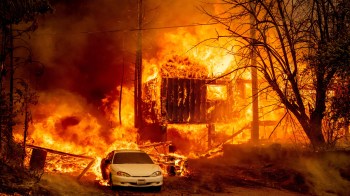Some cities want fewer roadways, not more
TEXT OF STORY
Kai Ryssdal: Vice President Joe Biden took the wraps off the administration’s most recent report card on the economic stimulus package today. The White House says — and this number is probably subject to political interpretation — that it has created roughly three million jobs in the past year or so. A lot of that work is being done on infrastructure, building and fixing bridges and highways. Dozens of cities around the country have just the opposite in mind though. They want to tear down parts of some freeways.
From WNYC in New York City, Andrea Bernstein reports.
Andrea Bernstein: Near the lower tip of Manhattan, Michael Sorkin is standing just yards from the East River and Brooklyn Bridge, but you can barely see them. So he looks up.
Michael Sorkin: We see traffic that is in at least three different levels. There’s the FDR Drive. There’s an interchange to get people onto the Brooklyn Bridge that’s flying over the FDR Drive, and then flying over that is the Brooklyn Bridge.
Sorkin is an architect and head of urban design at City College of New York. He’s drawn up a different blueprint for this patch of Manhattan. Tear down a section of the elevated highway, the on-ramps and cloverleafs.
Sorkin: You would see one of the most beautiful architectural achievements in the history of consciousness, the Brooklyn Bridge.
There would be parks, plazas, restaurants.
Sorkin: You would see boats cruising by.
Sorkin drew up these designs as part of an international exhibition by the group Institute for Transportation Development Policy. As crazy as it sounds, the idea of tearing down highways in dense urban areas is ricocheting around the country. Cleveland is planning to convert a lake-front expressway to a boulevard by 2012, and Seattle is moving to tear down a double deck highway by that same year.
Carmen Gand: I think it’s ridiculous.
Back in New York, teacher Carmen Gand was walking her dogs near the FDR Drive. Her reaction to a proposed teardown is typical.
Gand: People are going to drive into Manhattan regardless, so why not make as many roads or possibilities to get into Manhattan as possible?
It turns out that New York actually tore down an elevated highway in the 1970s. Sam Schwartz was the chief engineer for the NYC Department of Transportation then.
Sam Schwartz: And people panicked. They thought that was Armageddon.
The highway had begun to crumble, so the city dismantled 60 blocks and replaced it with a regular street.
Schwartz: After that, we had trouble tracing about one-third of the people. Transit went up. We had the same number of people coming in, but they weren’t coming in by cars.
San Francisco also lost freeways in the 1989 earthquake. Some years later, the San Francisco Chronicle wrote a story about it. The headline: “Traffic Planners Baffled by Success: No Central Freeway, No Gridlock, and No Explanation.” Engineers found that traffic volume had dropped from 93,000 cars a day to 45,000. But what happens in city where there isn’t a lot of public transit?
John Norquist: “You want to do what? Tear down a freeway?” Oh, they thought I was nuts.
John Norquist was mayor of Milwaukee from 1988 to 2004. He wanted to take down the Park East Freeway, which ran through downtown.
Norquist: A lot of people realized it was ugly and all that, but they said what would you do with the 40,000 cars a day that use it?
Norquist is now the president of the Congress for the New Urbanism, a group that promotes denser communities. He says in 2002, when he tore down the highway, downtown congestion didn’t jump. Instead, it dispersed all around city streets and business activity in the area went up.
Norquist: I’d don’t there’d be many people who say, “Milwaukee was a great place till that freeway got torn down.”
Skeptics remain, like Robert “Buzz” Paaswell. He says goods and services must be able to move through cities.
Robert “Buzz” Paaswell: You just can’t take out a link in a highway and expect nothing to happen.
Paaswell is an engineer who’s interim president of City College of New York. He says without city highways, some people will find it harder to get around. New York officials haven’t endorsed any plans to dismantle the southern tip of the FDR Drive. But around the country, mayors and governors are eying urban highway teardowns as the road to development, not congestion.
In New York, I’m Andrea Bernstein, for Marketplace.
Kai Ryssdal: The report is part of the public radio Transportation Nation project. For photos and links to some of the traffic studies, go to Marketplace.org.
There’s a lot happening in the world. Through it all, Marketplace is here for you.
You rely on Marketplace to break down the world’s events and tell you how it affects you in a fact-based, approachable way. We rely on your financial support to keep making that possible.
Your donation today powers the independent journalism that you rely on. For just $5/month, you can help sustain Marketplace so we can keep reporting on the things that matter to you.


















